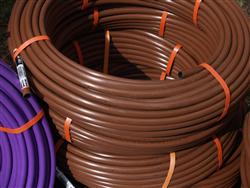
Design, install, maintain - take hold of your irrigation needs today!
Water is a precious and often scarce resource. Using it effectively can make all the difference to whether a crop is profitable or not!
This ten lesson course develops an understanding of how plants use water and how to deliver it more effectively to the plant.
Course Structure
This course has 10 lessons:
1. Introduction
2. Soil Characteristics and Problems
3. Estimating Plant and Soil Requirements
4. Drainage - drainage systems, dams, etc.
5. Types of Irrigation Systems
6. Hydraulics - discharge and flow rates, etc
7. Pumps and Filters
8. Selecting the Right System for the Plant
9. Trickle Irrigation
10. Design and Operation of Systems
Duration: 100 hours
 AIMS
AIMS
- Identify and consult appropriate sources of information for the irrigation industry.
- Explain the significance of soil characteristics to irrigation.
- Determine when to irrigate in a small scale situation.
- Explain the drainage aspect of handling water.
- Explain the operation and selection of irrigation systems.
- Explain the operation and selection of trickle irrigation systems.
- Determine specifications for the design of an irrigation system.
- Explain the pumps and filters needed for handling water adequately for crops.
- Supervise the installation of an irrigation system.
- Design and operate an irrigation system for crops.
“Whilst sharing similarities with other irrigation courses, this highly functional and practical course also has a specific focus on the irrigation of crops. It will be of interest to anyone who grows, or who wishes to grow, crops whether on a large or small scale. All aspects of irrigation from system types and design to pumps and filters are discussed, in light of soil characteristics, drainage, and plant requirements.” -- Jacinda Cole B.Sc., Cert. Garden Design, MACA, ACS Tutor.
 Erosion Management and Irrigation go Hand in Hand
Erosion Management and Irrigation go Hand in Hand
The wrong type of irrigation can cause soil erosion and other soil problems. Properly managed though, irrigation will not only grow better crops, but can also reduce the risk of erosion.
Erosion is a natural occurrence has been going on through most of Earth's history and has given us our river valleys and shaped our hills and mountains. Such erosion is generally slow however the action of humans caused a rapid expansion in the rate at which soil is eroded. This has resulted in a number of adverse effects including the loss of productive soil from crop and grazing land, layers of infertile soils being deposited on formerly fertile crop lands, the formation of gullies, silting of lakes and streams, and massive land slips. Humans have the capacity for major destruction of our landscape and soil resources. Hopefully we also have the ability to prevent and overcome these problems.
Water Erosion
 Several types of water erosion are common in our landscapes. These are:
Several types of water erosion are common in our landscapes. These are:
- Sheet erosion - occurs where a fairly uniform layer of soil is removed from an entire surface. This is caused by splash from raindrops, with the loosened soil generally transported in rills and gullies.
- Rill erosion - occurs where water runs in very small channels over the soil surface, with the water itself causing the abrading effect of the transported soil particles, resulting in deeper incisions of the channels into the soil surface. Losses consist mainly of surface soil.
- Gully erosion - occurs when rills flow together to make larger streams. They tend to become deeper with successive flows of water and can become major obstacles to cultivation. Gullies only stabilise when their bottoms become level with their outlets.
- Bank erosion - occurs during floods when large quantities of fast-flowing water cut into the banks besides streams and rivers. Soil removed from the banks is deposited downstream or in ocean outfalls, cause major destruction to property such as buildings, roads and bridges.
Why Study with ACS?
Design your own learning pathway.
Study at your own pace, from anywhere, at any time.
Receive prompt, expert support from our team of committed and friendly tutors.
Your learning is our priority. We are flexible and adaptable to meet your educational needs!
Enrolling is easy - just go to the top of this page and select your study method and payment option.
If you have any questions about studying with ACS, or want to know more about any of our courses, get in touch with our specialist tutors today.
They will be happy to answer your questions and look at different study options to fit in with your goals.